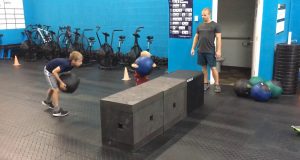Training for and competing in a triathlon is an excellent way to help you lose weight. A triathlon consists of a swim, a bike ride and a run. Participants complete each leg of the event starting with the swim leg and concluding with the run leg. The distance of each leg varies. There are very short events for novice athletes and longer events that are ideal for well conditioned amateur and professional athletes. Typical triathlon events include sprint events, Olympic distance events and Ironman distance events. Sprint events do not have set distances and may vary from one course to the next. The distances for an Olympic distance triathlon are 1.5K swim, 40K bike and 10K run, and the distances for an Ironman distance triathlon are 2.4 mile swim, 112 mile bike and 26.2 mile run. This article will focus on how tri-athletes enjoy an improved metabolism because of the cross training and speed work that helps them prepare for triathlons. While the information in this article will provide insight into the type of triathlon training that best facilitates weight loss, be sure to consult with your doctor before beginning your training program or taking supplements. This will help ensure you are fit enough to undertake this type of training and that any supplements you are taking will not interfere with prescribed medications.
Cross Training Keeps Your Metabolism High
One of the key reasons training for a triathlon is such an effective way to lose weight is the cross training that is necessary to prepare for competitions. Cyclists often focus solely on biking during the competition, while swimmers or runners likewise focus almost exclusively on their sport of choice. However, since a triathlon involves all three of these sports, tri-athletes have to concentrate on training for all three disciplines during the racing season. If you opt to train for a triathlon, you will find yourself enjoying the benefits of cross training while you prepare yourself for the swim, bike and run portions of the event.
As part of your triathlon training, consider training for an endurance cycling event such as a century ride. A century ride is a 100-mile bike ride, and most participants who are planning to participate in this type of event spend the vast majority, if not all, of their training time cycling to prepare for this event. While this might be good for your weight loss goals initially, as your body becomes accustomed to your workout schedule, you will begin burning fewer calories each time you ride your bike. This is due to improved muscle efficiency. This efficiency is ideal for improving your performance and your cardiovascular health, since as your muscles become more efficient, they require less fuel, but as a result, your weight loss will plateau, and you may become frustrated with your fitness routine.
Now consider training for a triathlon. You will have to prepare yourself to complete the swim leg, bike leg and run leg of the event. As a result, you will likely split your training time among the three disciplines to ensure you are adequately prepared for the event. By cross training and preparing yourself for three different events, you will prevent your muscles from becoming overly efficient. This will cause a significant metabolism boost during and after each training session. This metabolic boost will help you continue to lose weight while you train for your triathlon.
Speed Work Can Also Boost Metabolism
If you are training for your first triathlon, you will likely select a sprint or Olympic distance event. These races are significantly longer than the Ironman distance triathlons that many people associate with the sport. Shorter events such as these are ideal for novice athletes who are hoping to lose weight and enjoy participation in a competitive sport. Danskin even hosts a series of sprint distance triathlons for women entirely to encourage participation in the sport of triathlon. For more information on the Danskin Triathlon series, visit: [http://www.danskin.com/triathlon/triathlon.html].
Since you will likely be training for a shorter event, you will also likely incorporate some interval training into your swim, bike and run training sessions. Interval training essentially involves alternating short sprints with recovery periods where you are swimming, biking or running at a moderate pace that allows your heart rate to return to a more manageable level of approximately 50%-60% of your maximum heart rate. During the sprint intervals, you will be working at closer to 90% of your maximum heart rate. Your maximum heart rate can be roughly calculated by subtracting your age from 220. However, there are more effective ways to determine this number and you may wish to attempt them if you are not satisfied with the number determined from the basic formula. If you own a heart rate monitor with advanced features, it may include a fit test to help you determine this number. While you are training at a higher intensity, your metabolism increases greatly both during and after the training session. This increased metabolism can help you lose weight.
Supplement Your Diet to Keep Your Metabolism High
While triathlon training can help to keep your metabolism high, your diet can also have an impact on your metabolism. Making wise nutritional choices such as choosing fruits, vegetables and whole grains over processed foods, and incorporating supplements into your diet can also improve your metabolism. Visit http://www.Meltorin.com for more information about Meltorin, a metabolism-boosting supplement that can help you achieve your weight loss goals.
[ad_2] Crossfit Blogger News, Information and Bestselling Products
Crossfit Blogger News, Information and Bestselling Products




